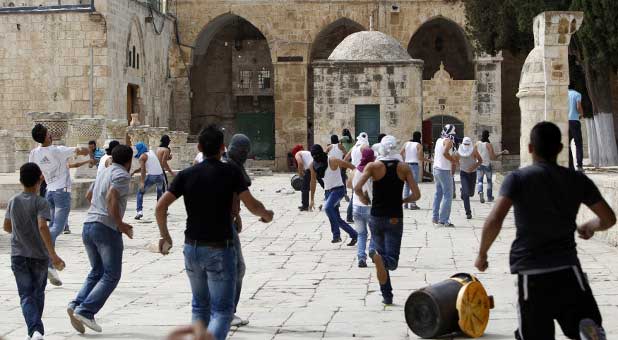Discerning Truth–and Lies–About Media Coverage of Israel
In Romans 9–11, the apostle Paul has just told us of God’s love for the Jewish people, their prophetic inheritance and His plans for their salvation. We have seen how reciprocal blessing flows between Gentiles and Jews as one in Messiah, to God’s infinite glory.
Next, in Romans 12:1–3, Paul tells us what to do with the information he has just unpacked. We must not conform to the pattern of this world; we must be transformed by the renewing of our minds in order to discern God’s will. For that we must know truth.
To know the truth about a given situation, we must usually be equipped with the facts. Concerning Israel, however, this can prove a daunting task. Every form of media imaginable communicates something, every day, about the Jewish state and its contention with Islamism, Arabs and Palestinians.
Often the narratives conflict and complexities are confusing. Many find it difficult to discern how reliable the seemingly boundless barrage of data can be. As a result, they may be misguided—or flatly manipulated—by raw emotion having little to do with facts or truth. They may believe whatever narrative of the conflict stirs the most sympathy—even if it happens to be fake. Allow me to share from personal experience.
World Pattern: The Media
My first visit to a Palestinian refugee camp was in 1982, but remains relevant today. From all the dreadful news reports even back then, I braced myself for the worst: row upon row of flimsily strung tents surrounded by piles of filth, men and women clothed in rags and crying children with runny noses and distended bellies. But that was not what I saw.
The camps I visited were neighborhoods quite decently built by Middle East standards of the day. The streets were calm. Women strolled casually about, groceries and other goods balanced on top of their heads. Men sat and sipped coffee together in the doorways of their shops. Palestinian children were off the streets and in school. Young Israeli soldiers leaned lazily at their posts, puffing cigarettes. Now and then a dog barked or a goat bleated.
I was more than a bit befuddled. The scene, while far from idyllic, hardly reflected the abject squalor and oppression widely reported by the media. Admittedly, I viewed only two camps, and neither would qualify for anyone’s list of residential best picks. Nevertheless, the refugees’ condition looked nothing like the deplorable imprisonment I had been led to expect. Later, I learned that Palestinians had experienced rapid and broad-based improvements in their standard of living shortly after the Israelis began “oppressively occupying” them.
Media distortions about the Arab/Palestinian–Israeli conflict have exponentially worsened since that visit decades ago. My last trip to the Palestinian West Bank left me dazzled and practically stunned. In 2012 I saw palatial homes, one after another, several times larger than my own.
Businesses were thriving. Large-scale ministry organizations operated in beautifully designed buildings, equipped with sleek appliances and updated technology. Certainly I do not deny that poverty exists among Palestinians. I do, however, suggest there is another side to the West Bank story—and that it is rarely told.
Inventing and Reinventing News
A sad reality is that in reporting on the Arab/Palestinian–Israeli conflict, facts and events may be egregiously misrepresented and truth disregarded altogether. Investigations reveal that some reporters and photographers regularly stage “news” events to shoot. Scripted scenes are acted out, depicting fictitious Israeli oppression, then released internationally as formal or informal reporting of facts. These highly distorted images, beamed electronically worldwide, aim to plant one picture in the global conscience: a viciously oppressive, Goliath-like Israeli pitted against brave, little Palestinian David. If, as the adage goes, one picture is worth a thousand words, it can also spread a thousand lies.
During Israel’s military operation in Jenin, for example, the world winced at photos of hapless and heartbroken Palestinian women wailing amid rubble that used to be called home. The untold back story was that “home” had been serving as a terrorist hideout or munitions plant for the murder of Jews—despite Israel’s repeated warnings to quit. In 2008, Palestinians in Gaza released presumed photographic evidence that Israel was inhumanely withholding electricity from them. Pictures of suffering innocents huddled in the dark were sent and seen around the world.
One photo of a roomful of “innocents,” however, betrayed a narrow streak of sunlight beaming through curtains that were not completely closed. The particular photo pictured Hamas leaders meeting in what was actually broad daylight, attempting to stage a nighttime scene. It turned out they had engineered the blackout themselves to gain sympathy and international support in their fight against Israel.
Dishonest depictions of Israel became so widespread that in 2011, an Italian photojournalist produced an exposé of it. He showed how some photographers cooperate with Palestinians to create news events by taking images of nonexistent conflict. He personally shot pictures of his colleagues photographing Palestinians who were posing in fighting positions for the other photographers who needed scenes they could sell. Once on the market, the pictures could be published with captions condemning Israel for any array of alleged abuses.
The exposé cautions that today’s media spins and sells to the world a narrative of the Palestinian-Israeli conflict that is biased and often unsubstantiated.
The preceding excerpt was taken from “Why Still Care About Israel?” by Sandra Teplinsky, from Chosen Books, a division of the Baker Publishing group. Copyright 2013, used by permission. For more information, visit bakerpublishinggroup.com.
Sandra Teplinsky has been in the Messianic Jewish ministry since 1979. She is president of Light of Zion, an outreach to Israel and the church based in Southern California and Jerusalem. She is an ordained minister and prophetic conference speaker, and has written several books and articles about Israel and the church.















































